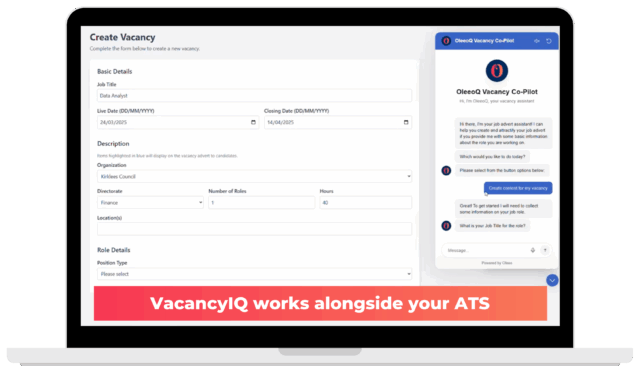The 10-Year Health Plan for England: How Technology and AI Will Revolutionise NHS Recruitment

The UK Government has recently published its “Fit for the Future: 10 Year Health Plan for England“. Beyond its goals of shifting care from hospital to community and from sickness to prevention, the plan signals a commitment to moving “from analogue to digital.” For recruitment and workforce development, this digital transformation, heavily powered by AI, promises to reshape how the NHS attracts, hires, and develops its invaluable talent.
As a provider of award-winning AI-powered recruitment tools, working with some amazing NHS trusts, including University Hospitals Birmingham, and Somerset, here’s how we see digital transformation and AI empowering recruiters and enhancing the experience for candidates in the coming decade.
1. Smarter Talent Attraction and Candidate Engagement
Gone are the days of purely reactive recruitment. The “Fit for the Future” plan hints at a proactive approach, leveraging data and digital transformation tools to identify needs and engage potential candidates earlier.
AI-powered insights will allow the NHS to understand workforce trends, predict future demands, and even identify potential skill gaps before they become critical. This foresight will enable targeted recruitment campaigns, reaching the right talent with compelling messages.
And, a digital transformed candidate experience will be paramount. Imagine candidates interacting with intelligent chatbots, powered by AI, that can answer their queries instantly, guide them through application processes, and provide personalised updates. This is where solutions like OleeoQ can shine, offering 24/7 candidate support and a truly engaging experience that reflects the NHS’s commitment to innovation and accessibility. However, it’s crucial to remember that recruiters will remain at the heart of the process, the candidate chat bot will reduce admin but recruiters will still have to set the goal posts and remedy any queries that have been escalated.
2. Streamlined and Bias-Free Application Processes
The plan’s focus on reducing bureaucracy and freeing up staff time directly translates to recruitment. Manual, time-consuming administrative tasks will increasingly be automated, allowing NHS recruiters to focus on strategic talent acquisition rather than paperwork.
AI-driven pre-screening and matching capabilities will become standard. Candidates uploading their CVs could instantly receive highly relevant job matches, not just based on keywords, but on a deeper understanding of their skills and experience. Our Candidate Navigator tool is specifically designed for this, using AI to match candidates to roles based on their competencies, helping them discover opportunities they might not have considered and ensuring a better fit from the outset. This also helps reduce unconscious bias by focusing purely on relevant skills.
The power of an advanced Applicant Tracking System (ATS) will be central to this. A robust ATS, with integrated AI capabilities, can automate everything from initial application processing and eligibility checks to interview scheduling and offer management. This not only speeds up the recruitment cycle but also ensures a consistent and fair process for every applicant.
3. Precision Screening and Skills-Based Hiring
The NHS is a vast and diverse organisation, requiring an equally diverse range of skills. The plan’s emphasis on “future-proofing the NHS workforce” by embedding digital and AI competencies in training pathways means a greater focus on identifying and assessing these vital skills during recruitment.
AI-powered assessment tools will play a crucial role here. Instead of relying solely on traditional CVs, the NHS can leverage solutions like Oleeo’s SkillsAssess to objectively evaluate candidates’ soft and hard skills. This technology can analyse responses to application questions, pinpointing evidence of desired competencies and even recommending a score for human review. This leads to more accurate and consistent screening, significantly reducing the time recruiters spend on initial sifting while promoting fairness and diversity.
4. Data-Driven Workforce Planning and Development
Beyond initial hiring, the “Fit for the Future” plan outlines a commitment to personalised career coaching and development for every NHS staff member. This will be underpinned by sophisticated data analytics and AI.
AI can analyse internal workforce data to identify skill gaps, predict attrition, and suggest optimal training pathways for existing staff. This proactive approach to workforce planning ensures the NHS has the right people, with the right skills, in the right places, now and in the future. Integrating recruitment data with broader HR systems will create a holistic view of talent, enabling continuous learning and professional growth that aligns with the evolving needs of the health service.
The Future is Now
For recruitment, the 10 Year Health Plan signals a dramatic shift towards a more technologically advanced, data-driven, and candidate-centric approach. Crucially, this involves deploying human-centric AI, where technology supports and amplifies the human element in recruitment, rather than replacing it.
By embracing AI and intelligent automation, the NHS can not only overcome its significant workforce challenges but also build a truly “Fit for the Future” talent pipeline – a pipeline that is efficient, equitable, and ultimately, delivers better care for everyone in England. Oleeo is proud to offer solutions that align directly with this ambitious plan, helping the NHS build the workforce it needs to thrive in the digital age.



